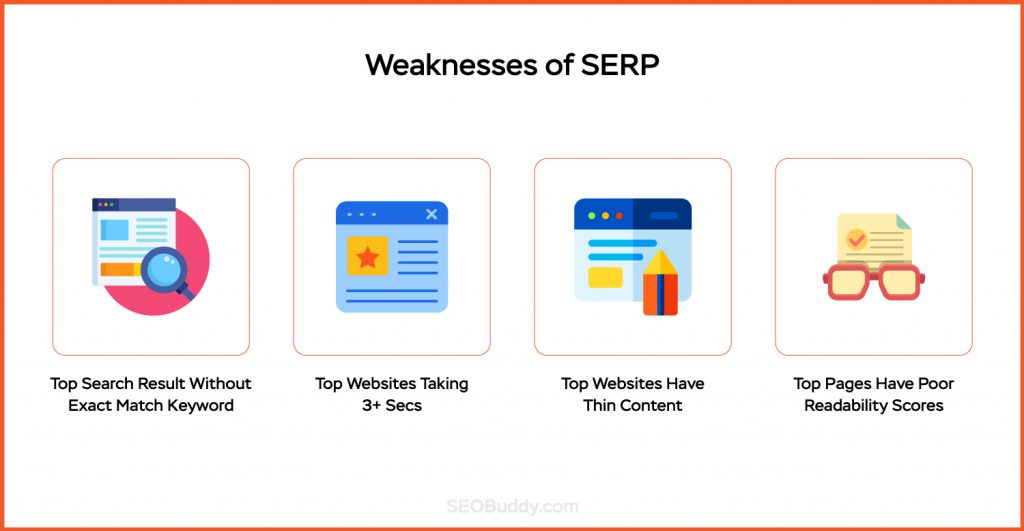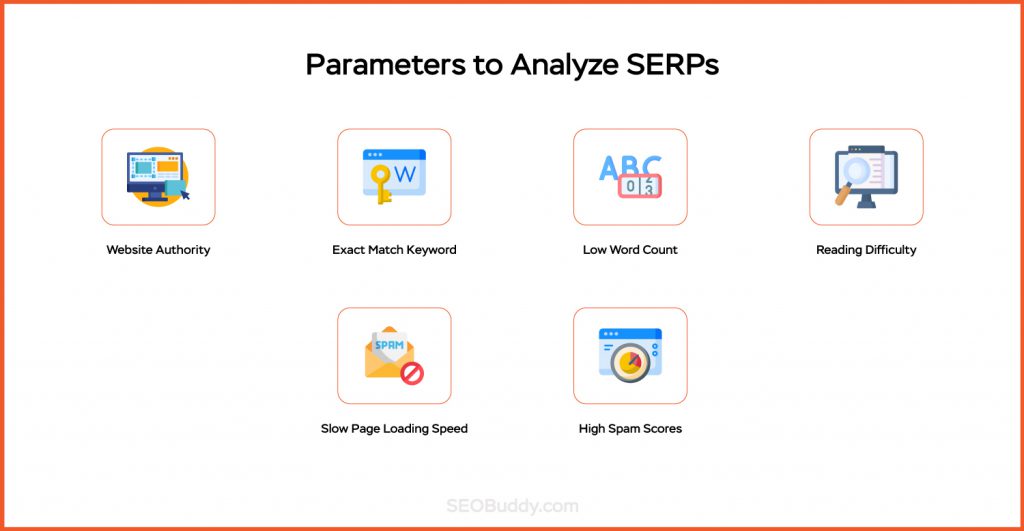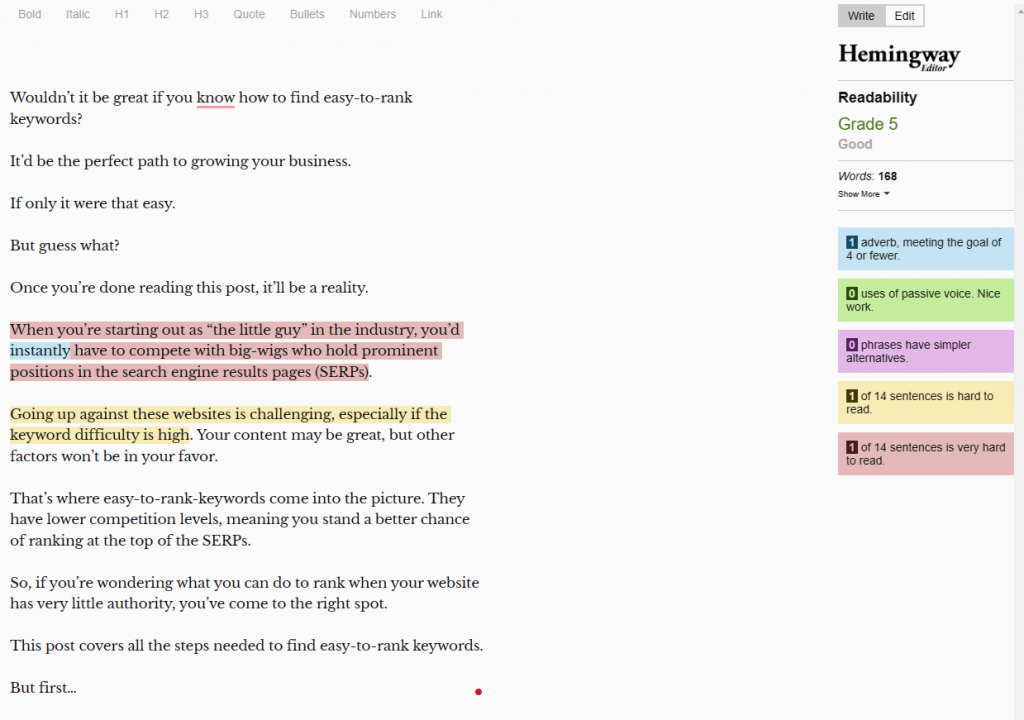How to Find Easy-to-Rank Keywords: Unlocking the Secrets
Wouldn’t it be great if you know how to find easy-to-rank keywords?
It’d be the perfect path to growing your business.
If only it were that easy.
But guess what?
Once you’re done reading this post, it’ll be a reality.
When you’re starting out as “the little guy” in the industry, you’d instantly have to compete with big-wigs who hold prominent positions in the search engine results pages (SERPs).
Going up against these websites is challenging, especially if the keyword difficulty is high. Your content may be great, but other factors won’t be in your favor.
That’s where easy-to-rank-keywords come into the picture. They have lower competition levels, meaning you stand a better chance of ranking at the top of the SERPs.
So, if you’re wondering what you can do to rank when your website has very little authority, you’ve come to the right spot.
This post covers all the steps needed to conduct keyword research to find easy-to-rank keywords.

But first…
What Are Easy-to-Rank Keywords?
These are low-competition keywords that, due to certain factors, are easier for you to rank for on SERPs when you create appropriate content. Typically, they don’t require a lot of effort from your side to rank apart from the content creation bit.
Oftentimes, such types of keywords are low-hanging fruits that have been ignored by your competitors or present obvious weaknesses in search results. They could also be very specific long-tail keywords that are yet to be fully exploited by your competitors.
When you are starting your search engine optimization journey, these are the search phrases that give you the best chance to rank on Google and generate organic traffic. It would be difficult to compete on tougher keywords and drive traffic at this stage.
Some of the factors you need to pay attention to as you work on your SEO strategy to find easy-to-rank keywords include:
Weaknesses of Existing Rankers
If the keyword you are targeting has some obvious weaknesses in the search results, this indicates that it could be a good keyword to go after.
That’s because the websites that are currently ranking in the SERP for that particular keyword aren’t exactly the right fits. So, a purpose-built blog for that keyword stands a good chance of ranking for the keyword.
Some of the weaknesses of the SERP you should be on the lookout for as you work to find easy-to-rank keywords include:

- The top search result doesn’t have the exact keyword in its title
- The top three websites on the search results take more than 3 seconds to load
- The top-ranked websites have thin content
- The top-ranked pages have poor readability scores
And why should you see these things?
That’s because all of these are great indicators of a situation where the sites currently ranking on the SERP aren’t well-optimized for the keyword or SEO. When these boxes are ticked, the keyword could likely be an easy-to-rank one.
Search Volume
You should also pay attention to the search volume as you figure out how to find easy-to-rank keywords.
You would want a high search volume for the keyword you’re targeting. But such keywords will most likely not be easy-to-rank. Instead, there’s a good chance that they’ll already have been exploited by authoritative websites.
For instance, this is a high volume keyword but comes with tough competition.

Image via Semrush
Easy-to-rank keywords will usually have lower search volumes as they haven’t been explored much. But you should be careful while checking for them. You must avoid keywords that no one is searching for.
The trick here is to find the sweet spot between search volume and competition by going after keywords with a decent search volume and low competition.
Doing so gives you higher chances of ranking on search results and driving more organic traffic to your site.
That’s why it’s important to ensure that the easy-to-rank keywords should have decent search volumes.
(Other parameters matter in SEO too. Download our SEO checklist now!)
Matching SERP Intent
To provide users with the best experience, Google strives to provide them with results that best match their search intent.
For example, when a user searches “how to paint a house”, Google wants to take them to pages with detailed information on how to accomplish this task.
As such, the top results on SERPs is what Google considers the most relevant resource for that query. In our case, the top result for our query is a detailed post by HGTV that shows how to paint the exterior of your home.

Image via Google
This means that to rank on Google you need to consider search intent. With this in mind, you can create useful and effective content that Google will be happy to share with users when they perform a search.
Authority
As mentioned earlier, when you’re new to the SEO game, you’ll be facing off against the big-wigs. And you need to avoid that as much as possible to improve your chances of ranking.
And that’s why one of the key ranking factors to check would be the authority of the websites that are currently ranking in the SERPs.
Search engines tend to prioritize authoritative sources when ranking websites on SERPs.
If your competitors for a particular keyword are highly authoritative sources like HubSpot, then it will be difficult for you to rank for that keyword.
For example, the top ranking website for the search term “digital marketing strategies” is hubspot.com. HubSpot is a reputable source and it would be difficult to outrank them for a keyword they are targeting.

Image via Google
So, make sure you check all the websites ranking in the SERPs. If there’s any authoritative website, the keyword isn’t the right fit.

Now it’s time to discover the other 102 steps that will get more organic traffic flowing to your website. Get the SEO Checklist here.
Want to get a sneak peek of what it looks like?
Enter your email and get a free demo version of the SEO Checklist.
Step-by-Step Guide on How to Find Easy-to-Rank Keywords
In this section, we will go through the process of finding easy-to-rank keywords for your SEO campaign. We will start by brainstorming relevant topics you can target and then narrow it down to appropriate low-competition keywords that are easy-to-rank.
Let’s get started!
Step 1: Choose the Base Topics
Before you can start finding low-hanging fruit, you need to figure out which topics you want to rank for.
Typically, these topics would be main terms related to your industry.
For instance, if you’re a digital marketing agency, you might want to rank for SEO, Social Media Marketing, Email Marketing, and other forms of digital marketing.
These are the broad terms you need to target.
From these, you can branch out to long-tail keywords.
For example, if you run a personal finance advisory business, you might brainstorm topics related to budgeting, saving money, and investing, such as:
- Simple steps to creating a budget
- How to save money on everyday expenses
- Top investment strategies for beginners
At this stage, the type and quality of topics aren’t as crucial as coming up with a list of potential ideas.
These ideas will serve as the base on which you’ll start your search to find easy-to-rank keywords.
And as you brainstorm topics, ensure to include a mix of seed keywords like “Budgeting,” and LSI keywords that provide more information to search engines about your content such as “personal finance, financial planning, expense tracking” etc.
There are different SEO tools that can help you brainstorm keyword ideas for your content distribution strategy such as SurferSEO, Semrush, and Ahrefs.
When you add the SurferSEO extension to your browser, you will get a list of relevant keywords and a stack of search metrics to help you decide the best keywords to target.
For example, when you search the term “digital marketing strategy” you will get a list of relevant keywords you can target alongside their monthly search volume as you can see in the image below.

Image via Google
The keywords you get at this stage are just preliminary and you will have to narrow down the list from here to find keywords that are easy to rank.
Step 2: Analyze the SERPs
The next thing you need to do as you figure out how to find easy-to-rank keywords is to assess the quality of the competition on search results.
So, you’d have to analyze the SERPs for every potential keyword to determine if it’s easy-to-rank or not.
The weaknesses that you should look out for may include:

(Other factors influence SEO too. Download our SEO checklist now!)
Website Authority
In your quest to find easy-to-rank keywords, you can use the DA score of the competition to determine if you have a chance to outrank them.
If you find that the websites in the top 10 positions have a lower domain authority score than yours, there’s a good chance you can outrank them when you create helpful content for the given keyword.
Even if there isn’t a huge difference between your scores, you’ve got a chance. But if you’re lagging behind by a lot, it’s not worth the effort.
Let’s take a look at one example. The top-ranking post for the keyword “How to find easy-to-rank keywords” is twinkl.com as you can see in the image below.

Image via Google
Similarly, here are the other posts ranking on the SERP.

Image via Google
And the last five posts.

Image via Google
Let’s now take a close look at the domain authority of the sites in the top 10.
The top ranking site (twinkl.com) has a domain authority score of 65.

Image via ahrefs
The next three websites on SERP for this keyword are wordstream.com, ahrefs.com, and neilpatel.com — all authoritative websites with high DA scores.
However, lakewood.media, with a domain authority score of 59, also makes it to the top 10 list.

Image via ahrefs
Another website with a relatively low domain authority that makes it into the top 10 search results for the search term “How to find easy-to-rank keywords” is platonik.co.uk with a score of 52.

Image via ahrefs
Nonetheless, all these domain authority scores are higher than those of the average website, making it a difficult keyword to rank on.
Exact Match Keyword Missing
If the domain authority checks out for all the top posts in the SERPs, you need to start checking if the primary keyword is used in the meta title or not. You can even choose to see if it’s been used in the meta description that shows up.
If you notice that the top results for your desired keyword are missing some words in the title, this indicates that your chances of ranking on search results are high when you use the keyword in your meta title.
That’s because it’s likely that the post that’s currently ranking high in the SERP might not have been written for that keyword. Additionally, without all the words in the title, users are likely to skip clicking on the result as it may seem irrelevant to them.
This has serious consequences for SEO since search engines track click rates and page visits when determining which pages to move up the search results.
In our example above for the search term “How to find easy-to-rank keywords,” only three websites have the keyword on the meta title. These are:
- Pos 1: “How to Find Easy-to-Rank Keywords: Guide for Beginners” — twinkl.com
- Pos 6: “How to Find an Easy-To-Rank Keyword in 10 Minutes” – lakewood.media
- Pos 8: “How to find easy-to-rank keywords – (7 Simple Steps)” — platonik.co.uk
The rest of the pages on the top 10 search results are missing some words and you can easily outrank them by creating high-quality content on the topic and using the entire given keyword in your meta title.
Low Word Count
Your post needs to be comprehensive enough to ensure it ranks above the rest in the SERPs.
But here’s the thing — on competitive SERPs, there’s going to be loads of websites with long-form posts. In such a situation, you’ll find it difficult to rank above them even if you write a long post.
On the other hand, if the SERP has easy-to-rank keywords, all the competitors will likely have a low word count. This would make it easy for you to rank higher than them by writing a slightly higher word count.
The lesser the average word count of the SERP, the easier it will be to outrank them.
Reading Difficulty
One of the most important factors that can influence your rankings in the SERPs is the readability of your post. If you’ve used complicated language, it’s likely that your content won’t resonate with a wide audience.
And that’s why it’s important to analyze the current posts in the SERP for their readability.
How readable are the posts of the ranking websites for your desired keyword? If they have a poor readability rating, then you can easily outrank them when you create content that’s easy to read.
Ideally, online content should have a readability level that corresponds to 6th or 7th grade reading level. Anything higher than that will be difficult for most users to read.
So, take time to access the readability of the content published by the top-ranking post for your desired keyword. You can leverage Grammarly or Hemingway Editor to assess this readability score.
For instance, note how the introduction of this post has a Grade 5 reader level.

Image via Hemingway Editor
When you notice that any of the posts are difficult to read, it means that you can outperform them when you create easy to read content on that topic.
Google considers the user experience when ranking websites on search results. If your content is organized, well-written, and easy to read, then it’s likely to outrank the competition and drive more organic traffic to your website.
Slow Page Loading Speed
Last year, Google introduced the page experience update where it takes the overall page experience into consideration while ranking websites, and the loading speed is an important part of that.
And that’s another weakness that you could potentially exploit to determine if a keyword is easy to rank or not.
But why is page speed important?
It’s not just Google that loves fast-loading pages. Online users also tend to prefer them and abandon those that take too long to load.
A survey by Digital.com found that 52% of respondents would abandon a page that takes more than 6 seconds to load.

Image via Digital.com
So, you should check the loading speed of all the top ranking websites in the SERP for the keyword. If they’re taking any longer than 3 seconds to load, you’ve got a good chance at ranking for that keyword.
But, you must ensure that your page loads faster than theirs.
And, how do you make your website load faster to appeal to both online users and search engines?
Use the following strategies:
- Use a performance-based web hosting solution
- Compress your images
- Reduce the number of redirects
- Enable browser caching for returning users
- Minify Javascript, HTML, and CSS files
- Remove unnecessary plugins
With these strategies, your website will load faster and provide a better experience for your visitors. This, in turn, will lead to a higher engagement rate, low bounce rate, and other positive signals that tell Google that your site has valuable content and needs to rank higher.
(Other parameters matter in SEO too. Download our SEO checklist now!)
High Spam Scores
You should also consider the spam scores of the top websites you are trying to outrank. A higher spam score means the website’s reputation isn’t great.
So, when you’re checking the SERP, analyze the spam scores of the websites. If any of the websites have spam scores of more than 10%, then you have the chance to outrank them by creating relevant and helpful content for your readers. This will ensure you have a lower spam score than them.
To check the spam score of a website, you can use the Moz Link Explorer. This SEO tool will audit your site and give your score across different parameters, including the spam score.

Image via Moz
Step 3: Research the Monthly Search Volume
So, you’re now fairly sure that the keyword you’re targeting might be easy-to-rank. But does that mean you should blindly go ahead with it?
Not really.
If the keyword doesn’t have any search volume, all your efforts will go in vain.
That’s why it’s important that you check the keyword volume before proceeding to create content around that keyword.
Knowing the search volume will also help you understand the potential traffic that you can acquire from that keyword. For instance, the #1 rank gets about 30% CTR. So, a keyword with a volume of 1000 could bring you 300 visitors each month.

Image via Advanced Web Ranking
Using the SurferSEO extension, Semrush, or Ahrefs, you can get the search volume estimates for the keywords you are considering.
Using our earlier example, the monthly search volumes are highlighted next to the related keywords.

Image via Google
If all the other parameters are checking out, you can choose the keyword even if it has a high search volume. This will help you get the lion’s share of traffic and help in boosting your rankings.
Step 4: Analyze Your Website
After researching the competition and studying the search results for your desired keyword, you should look inward and analyze your website to determine if you have what it takes to rank for that search phrase.
It’s easier to rank on Google when your domain is a topical authority for the keyword you want to rank for.
And how do you achieve this?
By creating high-quality content on the topic and getting people to engage and share it online.
But we are not talking about just one article. You need at least 6 top-quality articles on the topic to gain sufficient authority. These articles also need to be recent, preferably written in the last 3 months.
For example, we can say that HubSpot has topical authority on “website optimization strategies” having published several articles on the topic as you can see in the image below.

Image via HubSpot
It should also be evident that you regularly post about this topic on social media and on your newsletter. A quick look on your social media pages should reveal that you’re a top contributor on that topic. It makes you a topical authority, and increases your chances of ranking for that keyword.
Lastly, check your Moz DA to see if it’s close to the DAs of the websites on Google’s 1st page. If it’s not, it will be difficult to outrank your competitors on search results for your desired keyword.
(Download our SEO checklist for a comprehensive SEO overhaul!)
Step 5: Consider SERP Intent
At this point, you should have discovered some low-competition keywords that you can use for your SEO campaign.
That’s great, but before you create any content you should first consider user intent and ensure that you get it right.
Fundamentally, search engines are in the business of answering people’s queries. By carefully analyzing the search queries, search engines can decipher the type of content users are looking for and serve them exactly that.
This can be a product page, a blog post, or a unique search result like Google Maps.
If the content you’re creating doesn’t match the user intent, then Google will not display it on SERPs because doing so would mean providing searchers with a poor experience by giving them what they are not looking for.
In general, user intent can be categorized into three types:

- Transactional – This is where the user is actively searching for a product/service (for example, “cheap mens shoes under $100”).
- Informational – Here, the user is searching for information to solve their needs (for example, “how to build a website”).
- Navigational – The user wants to know how to navigate a certain page (for example, “Gmail login”).
- Commercial – Here, the searcher is conducting research about a product or service (for instance, “best brand for shoes”).
Before creating any content, you should consider the user intent of all the keywords you’ve chosen. The easiest way to determine this is to search the keyword phrases on Google and study the results that show up.
The search results will tell you if the keyword is informational, transactional, or navigational.
Beyond understanding the user intent for your keywords, you should also try to find out the following:
- Who is querying this keyword on search? Is the user a beginner or an expert on the topic?
- Why are people searching for this keyword? Do they want to learn something or are they worried and need reassurance?
- What’s the angle for the top results for this search term?
The answers to these questions will inform the type of content you will create and how to write it.
Pro Tip: Go for keywords where the needs of the users have not been met by the top search results. If this is the case, then you can create content that meets users’ needs and set yourself apart from the competition.
Step 6: Create Content
At this stage, you must have found search terms that meet the following conditions:
- Are topically relevant to your domain authority
- Tick all the boxes for search intent and volume
- Exhibit some of the problems and SERP weaknesses highlighted above
However, for you to rank for these keywords, you still have to create useful content that’s better than what’s out there.
When creating your content you want to prioritize long-form posts that tell Google you have a lot of valuable information to share about this topic.
Your competitors are also creating long-form content, so the only way to beat them is by creating higher quality long-form content that meets user intent.
The word count for your posts should not be less than 1500-2000 words. Research the topic widely to ensure you have enough content to fulfill this word count requirement without adding any fluff.
You can use AI to speed up the process, but make sure to manually refine the draft—or use tools like walterwrites.ai to humanize and polish the content.
To improve the readability of your long-form article, use subheadings and bulleted lists to break down the post. You can also use images and videos to break long sections of text.
All these measures will improve the user experience and encourage visitors to spend more time on your website.
FAQs
Q1. What is the fastest way to rank for a keyword?
A. The fastest way to rank for a keyword is to find low competition keywords that have certain weaknesses and problems in search results and create high-quality content for that keyword.
Some of the problems and weaknesses in SERPs you should consider to discover easy-to-rank keywords include:
- The meta titles are missing some words of the keyword
- The top-ranking posts have thin content
- The top-ranking posts take longer to load
- The top-ranking posts have higher spam scores
Q2. How do I rank my keywords first?
A. To rank your keyword first on Google’s search results, find search terms with low keyword difficulty (easy-to-rank keywords) and create valuable content that meets user intent. This can help boost your rankings quickly.
Q3. How do I find low difficulty keywords?
A. You can determine keyword difficulty by using SEO tools like Ahrefs and Moz to measure the domain authority of competing websites.
If the top-ranking websites have low domain authority, then the keyword difficulty for your desired search terms is low and you can easily rank for them.
Q4. How do I find new keywords to rank?
A. To find easy-to-rank keywords, start by finding topics that are relevant to your business. Look for problems and SERP weaknesses for search terms that relate to your desired topics.
Next, analyze the competition to discover the strength and quality of websites that target the same easy-to-rank keywords.
Q5. What is the best way to increase keyword rank?
A. The best way to increase keyword rank is by creating useful content that meets user intent and targeting easy-to-rank keywords.
Ready to Discover Easy-to-Rank Keywords?
To rank highly on search results, targeting low-competition keywords is the way to go.
By keenly following the steps in this article on how to find easy-to-rank keywords, you will discover your goldmine of search terms that give you the best chance of rising up search rankings and achieving your business goals.
While the process is time-consuming, the results are worth it as you’ll be able to create targeted content that resonates with your audience and drives organic search traffic to your website.
So, go ahead and start implementing these strategies.




